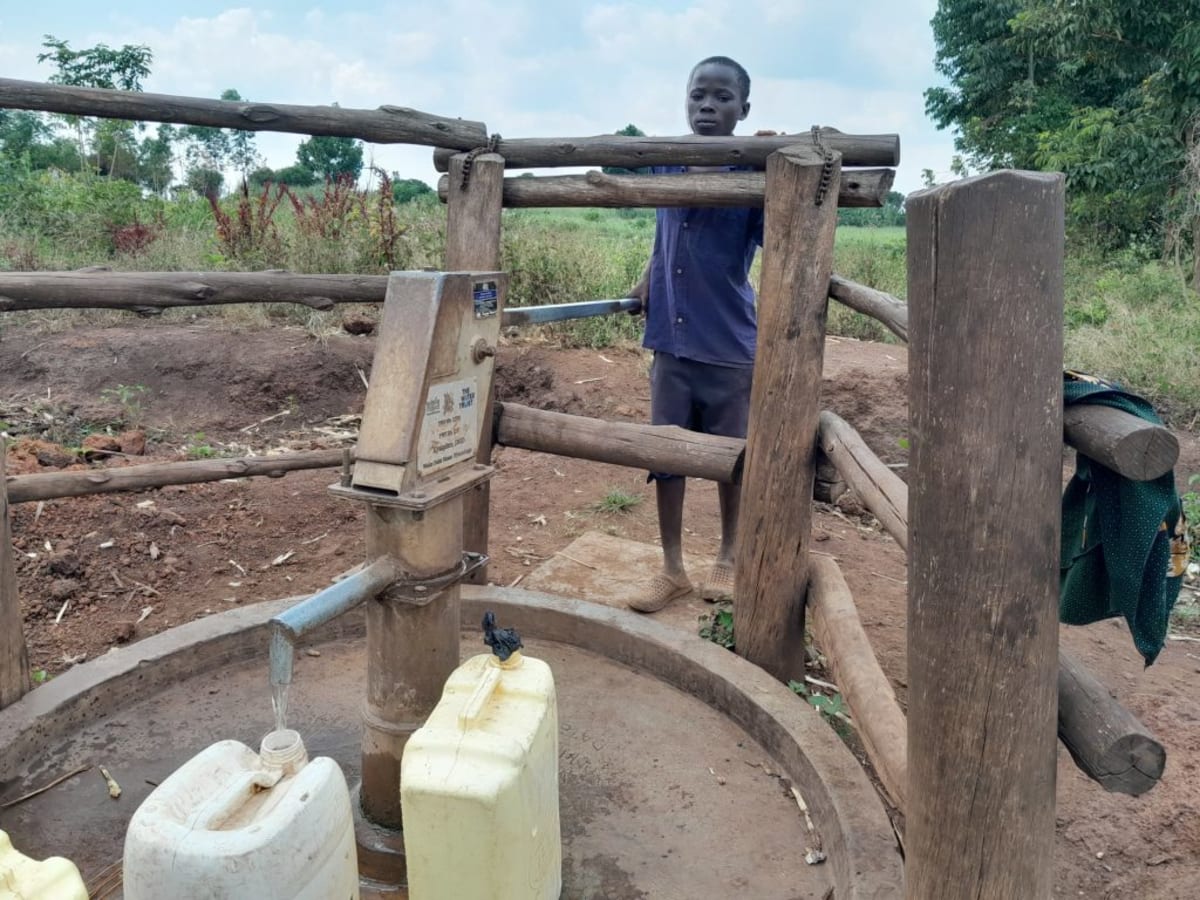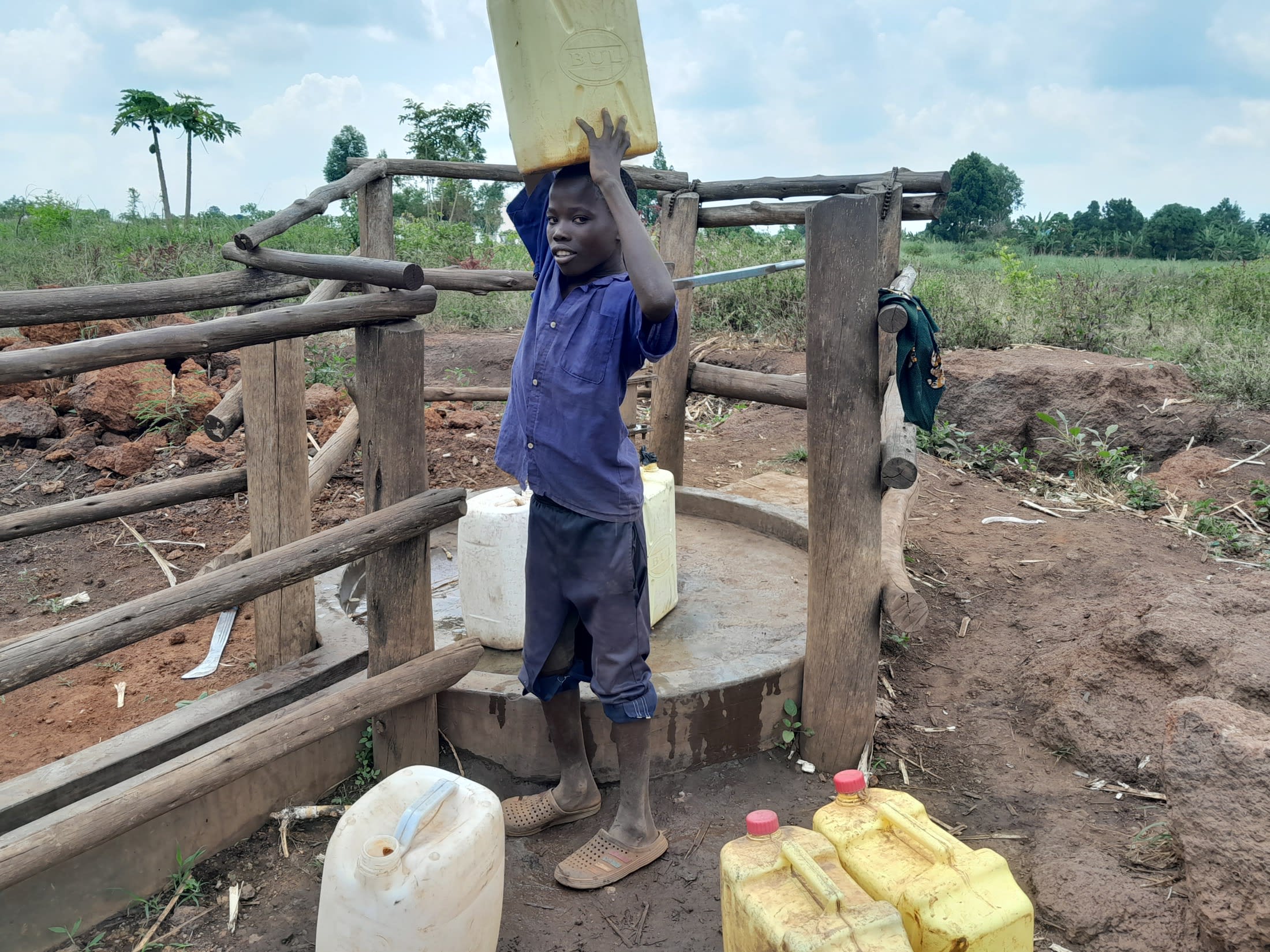The shortest amount of time it takes for the 480 people in Kyakaitera Community to reach their water point is an hour each way. Depending on how much water people use, they could be spending four hours or more per day just fetching water for their daily routines.
"I always go to collect water twice every day in the mornings and in the evenings," said Gloria, a 12-year-old girl who lives in the community. "However, due to the long distance and the queues at the borehole, there are always several struggles and fights, which force me to delay at the source. At home, my mother [punishes] me and blames me for the delayed domestic activities, like preparing food and washing utensils."
Kyakaitera used to have two borehole wells the community members could use, but one has recently broken down. So those who once used the old well now have no choice but to journey across town, through seemingly endless fields of beans, maize, and sugarcane, and then back again...twice per day.

Magaret Nanyonjo, a 60-year-old farmer, explained: "In this village, if you don't have a bicycle, collecting water is a major challenge. [Due to] the fact that I don't have one, I have to walk, and it takes me about 2 hours to get water. At the well, there is always a lot of congestion. [I] am pushed, and I really feel disturbed each time [I] am at the water point. No one cares about how I feel."
It's no wonder the community members have resorted to digging their own holes in the nearby ground from which to collect water. But that means they have no idea how safe the water they're using is.

Children and adults alike suffer from diarrhea, scabies, and other skin diseases. The community members - especially the women and girls, whose days start at 5am and don't end until 10pm or later - are exhausted.
"We don't have time to rest," said Amina Asaba, a local. "We prepare supper, bathe the children, and wash the utensils (dishes) while the men head out to the trading centers to rest and meet friends. Supper is served by 9:00 pm, after which we go to bed."
"I am kindly requesting [The Water Project] to provide this catchment a water source to save us from all these challenges," Magaret concluded.
Here’s what we’re going to do about it:
New Borehole
This new borehole is an exciting opportunity for this community! We work with the community to determine the best possible sites for this well.
We conducted a hydrogeological survey and the results indicated the water table is an ideal candidate for a borehole well. Due to a borehole well's unique ability to tap into a safe, year-round water column, it will be poised to serve all of the water needs for this community, even through the dry months.
Community members will help collect the needed construction materials such as sand, rocks, and water for mixing cement. They will also provide housing and meals for the work team, in addition to providing local laborers. We will complement their materials by providing an expert team of artisans and drilling professionals, tools, hardware, and the hand-pump. Once finished, water from the well will then be used by community members for drinking, handwashing, cooking, cleaning, and much more.
Training
Training’s main objectives are the use of latrines and observing proper hygiene practices since these goals are inherently connected to the provision of clean water. Open defecation, water storage in unclean containers and the absence of hand-washing are all possible contaminants of a household water supply. Each participating village must achieve Open Defecation Free status (defined by one latrine per household) prior to the pump installation for this borehole well.
This social program includes the assignment of one Community Development Officer (CDO) to each village. The CDO encourages each household to build an ideal homestead that includes: a latrine, a handwashing facility, a separate structure for animals, a rubbish pit and a drying rack for dishes.
We also implement the Community-Led Total Sanitation (CLTS) approach with each of our village partners. This aims to improve the sanitation and hygiene practices and behaviors of a village. During these sessions, village leaders naturally emerge and push the community to realize that the current practices of individual households – particularly the practice of open defecation – are not only unhealthy, but affect the entire village. CLTS facilitates a process in which community members realize the negative consequences of their current water, sanitation and hygiene behaviors and are inspired to take action. Group interactions are frequent motivators for individual households to build latrines, use them, and demand that other households do the same.
Improved Sanitation
The aim is that all households own an improved latrine. Many households do not use a latrine but use the bush. Due to open defecation, feces are spread all over the village. This leads to waterborne diseases and contamination of groundwater and surface water. Our aim is that the community is able to live a healthy life free of preventable diseases. We endeavor that at the end of our presence in the community, people will have both access to sustainable, clean water and access to sanitation. We have now organized families to form digging groups for latrine construction, and empowered them with tools to use.

 Borehole Well and Hand Pump
Borehole Well and Hand Pump
 Rehabilitation Project
Rehabilitation Project





























